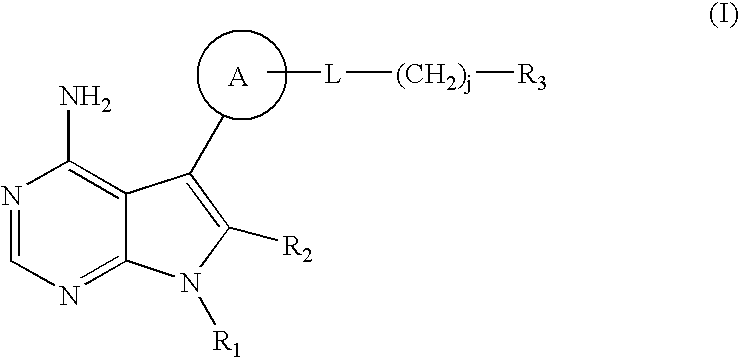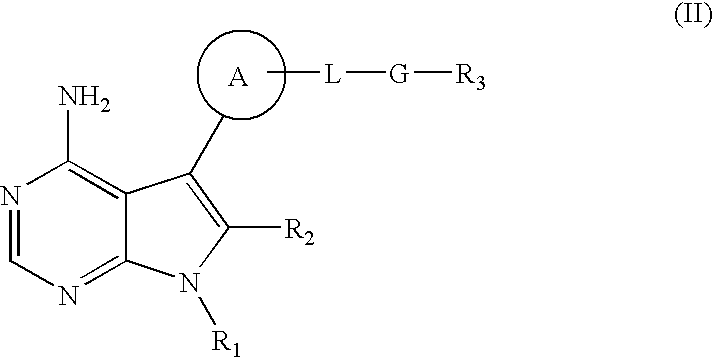Method of treating transplant rejection
a transplant and treatment method technology, applied in the field of transplant treatment, can solve the problems of serious infection, increased reduced white blood count, and achieves the effects of reducing the risk of cardiac disease, serious infection, and reducing the risk of malignancy
- Summary
- Abstract
- Description
- Claims
- Application Information
AI Technical Summary
Benefits of technology
Problems solved by technology
Method used
Image
Examples
example 1
trans-N2-(4-{4-amino-1-[4-(4-methylpiperazino)cyclohexyl]-1H-pyrazolo[3,4-d]pyrimidin-3-yl}-2-methoxyphenyl)-1-methyl-1H-2-indolecarboxamide
A suspension of trans-N2-(4-{4-amino-1-[4-(4-methylpiperazino)cyclohexyl]-1H-pyrazolo[3,4-d]pyrimidin-3-yl}-2-methoxyphenyl)-1-methyl-1H-2-indolecarboxamide di-maleate (0.200 g, 0.242 mmol) in dichloromethane (15 mL) was treated with 1N sodium hydroxide solution. The reaction mixture was stirred for 1 h at room temperature. The layers were partitioned using an Empore extraction cartridge. The organic layer was removed by blowing nitrogen over the top of the solvent to give 0.072 g (50%) of trans-N2-(4-{4-amino-1-[4-(4-methylpiperazino)cyclohexyl]-1H-pyrazolo[3,4-d]pyrimidin-3-yl}-2-methoxyphenyl)-1-methyl-1H-2-indolecarboxamide. 1H NMR (d6-DMSO) δ 9.4355 (s, 1H), 8.2464 (s, 1H), 8.1241-8.1037 (d, 1H, J=8.16 Hz), 7.7186-7.6987 (d, 1H, J=7.96 Hz), 7.6005-7.5795 (d, 1H, J=8.4 Hz), 7.3532-7.2795 (m, 4H), 7.1717-7.1343 (t, 1H), 4.6833 (m, 1H), 4.05...
example 2
trans-N2-(4-{4-amino-1-[4-(4-methylpiperazino)cyclohexyl]-1H-pyrazolo[3,4-d]pyrimidin-3-yl}-2-methoxyphenyl)-1-methyl-1H-2-indolecarboxamide di-mesylate
A warmed solution of trans-N2-(4-{4-amino-1-[4-(4-methylpiperazino)cyclohexyl]-1H-pyrazolo[3,4-d]pyrimidin-3-yl}-2-methoxyphenyl)-1-methyl-1H-2-indolecarboxamide (0.072 g, 0.12 mmol) in ethyl acetate (20 mL) was treated with methane sulfonic acid (0.012 g, 0.12 mmol). A precipitate slowly formed and was filtered under a nitrogen atmosphere to give 0.051 g of trans-N2-(4-{4-amino-1-[4-(4-methylpiperazino)cyclohexyl]-1H-pyrazolo[3,4-d]pyrimidin-3-yl}-2-methoxyphenyl)-1-methyl-1H-2-indolecarboxamide di-mesylate. The melting range was determined to be 345.5 to 348.1° C. 1H NMR (d6-DMSO) δ 9.4353 (s, 1H), 8.2461 (s, 1H), 8.1239-8.1035 (d, 1H, J=8.16 Hz), 7.7182-7.6985 (d, 1H, J=7.88 Hz), 7.6004-7.5792 (d, 1H, J=8.48 Hz), 7.3442-7.2794 (m, 4H), 7.1718-7.1349 (t, 1H), 4.6829 (m, 1H), 4.0396 (s, 3H), 3.9570 (s, 3H), 2.6703 (m, 6H), 2.5 (s,...
example 3
Example 3 was prepared according to PCT Publication WO01 / 19829, which is incorporated herein in its entirety. Example 3 was solubilized in dH2O.
Anti-CD3 Induced IL-2 Production
Six to 8 week old BALB / c mice were dosed p.o. with EXAMPLE 3 30 minutes prior to i.v. injection of 75 ng hamster anti-mouse CD3 antibody, 145-2C11 (PharMingen, San Diego, Calif.). Two hours after anti-CD3 injection mice were bled via cardiac puncture, serum was collected and assayed for IL-2 by ELISA (Endogen, Woburn, Mass.).
Antigen Induced Cytokine Production
A modification of a method described by Magram, J., Turek, C. W., Killeen, N; Immunity, 4: 471, 1996 was utilized. Briefly, C57BL / 6 mice were immunized intradermally on day 0 with 200 μg MOG35-55 (myelin oligodendrocyte glycoprotein peptide) (New England Peptide, Inc., Fitchburg, Mass.) in a 1:1 emulsion with complete Freund's adjuvant (Difco Labs., Detroit, Mich.). Mice were treated daily, p.o. with vehicle or EXAMPLE 3 from day −1 through day 6. ...
PUM
| Property | Measurement | Unit |
|---|---|---|
| Ri | aaaaa | aaaaa |
| covalent | aaaaa | aaaaa |
| Ra | aaaaa | aaaaa |
Abstract
Description
Claims
Application Information
 Login to View More
Login to View More - R&D
- Intellectual Property
- Life Sciences
- Materials
- Tech Scout
- Unparalleled Data Quality
- Higher Quality Content
- 60% Fewer Hallucinations
Browse by: Latest US Patents, China's latest patents, Technical Efficacy Thesaurus, Application Domain, Technology Topic, Popular Technical Reports.
© 2025 PatSnap. All rights reserved.Legal|Privacy policy|Modern Slavery Act Transparency Statement|Sitemap|About US| Contact US: help@patsnap.com



